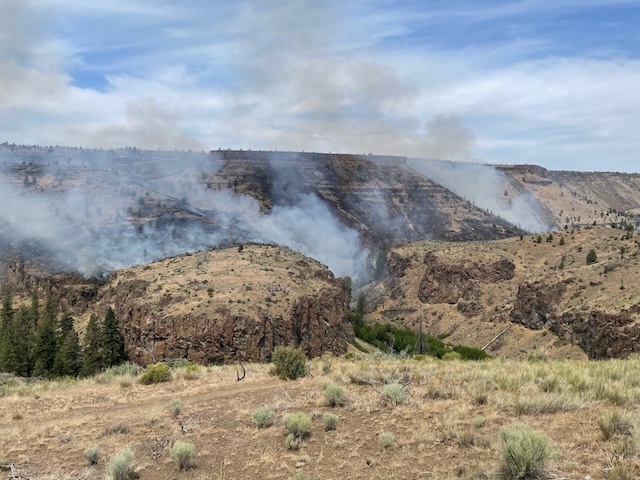Using data to make smart decisions
Published 5:00 am Monday, September 2, 2013
Spencer Sanvitale spent part of the summer walking among graves in the city-owned Pilot Butte Cemetery, mapping the burial plots with a GPS unit.
As a result of his work, the city for the first time has a map of the cemetery with GPS points that it can use to track maintenance work, plot sales and other data. Sanvitale is the program manager for data services and asset management in the Bend Public Works Department, so he is involved in many of the city data-gathering projects.
“I think the overall goal of what we’d like to do with the cemetery is have points on a map to show if a plot is available, and maybe prices attached to it so it’s easier for people to make choices,” Sanvitale said.
Sanvitale’s cemetery project is part of a citywide effort to collect better data on assets and operations, from property the public owns to the hours employees work on individual projects. The city plans to use that information to guide both daily operations and major policy and spending decisions.
The city already collects data on, for example, debris street cleaners pick up and the cost to fill individual potholes.
Water meters in many homes send usage data to the city in real time, and utility workers can detect dramatic changes in water usage at a particular home. When water use increases significantly, the city contacts the residents to find out if there is a leak. The Police Department hired a crime analyst and recently began providing monthly reports on important budget and crime statistics.
The next major city data project will be to collect images of sidewalks, streets and all city signs this fall with a camera mounted on a vehicle, similar to Google Street View.
City employees said this information helps them operate more efficiently, and helps city councilors and other leaders make more informed policy decisions. Still, the city is in the early stages of collecting and using data.
“Right now, we’re at a relatively early stage in really using data to drive city decisions and drive efficiency,” said city IT Manager Randy James. “So we’re really in the stage right now where we’re primarily focusing on data collection and ensuring the data we collect is accurate. … In terms of being on the cutting edge to use data to really drive the business of the city and where we’re going, we’re sort of in an infancy stage.”
Sanvitale said the city purchased asset management software in 2008 at the direction of Public Works Director Paul Rheault, who used similar programs at previous jobs. This software allows the city to track how often individual pieces of equipment are used, how much time employees spend working on particular jobs, and much other information. Since then, employees have worked to gather the data necessary for the city to get the most out of this system.
“It’s just been in the last three years with Infor (the asset management software) that we’ve been able to collect true costs for staff and materials,” Sanvitale said.
After the real estate crash, Sanvitale had more time to collect data. Now that the economy is improving, more developers are contacting him to find out where there is vacant land and available capacity for them to connect to the sewer.
Meanwhile, the city is testing whether employees can gather data more accurately and efficiently when they take computers with them in the field, “rather than coming back at the end of the day and trying to get caught up on their (handwritten) notes,” Sanvitale said. A city pilot project put tablet computers in the hands of some public works employees. James hopes to also provide tablet computers to the Community Development Department sometime soon, so that building inspectors and planners can use them in the field. The department already uses laptops, but employees cannot carry the laptops and enter information while touring a construction site.
Firefighter paramedics will also soon have tablet computers in their ambulances, so they can begin to use patient-care reporting software to track services they provide to patients. This will be more accurate than the current paper forms, on which mistakes and handwriting that is difficult to decipher make it difficult for the city to bill insurers, James said. The electronic patient-management system will cost an estimated $75,000, according to city budget documents.
The budget for the street imagery project this fall is $40,000, James wrote in an email. The city will use these images to create a database of all city signs, with their GPS locations. Some signs are already in a city database, but Sanvitale said there are “thousands and thousands” of street name and other signs that have not been recorded.
“It would allow us to do, for the first time ever, a total inventory of signs,” said Street Division Manager Hardy Hanson. The city will also check for missing street striping, and use the images to add to its inventory of sidewalks. Hanson said the images will lead to more accurate data.
“You have one or two people that look at this screen and they can focus their time and get it done, as opposed to all the travel time and ancillary things they do,” Hanson said. Plus, employees can log data from the images even when snow covers sidewalks and other infrastructure this winter.
Sometime soon, the city will also map and create a database of the landscaped features it owns around the city. This could allow the city to, for example, identify through the database a location where the irrigation system is consistently malfunctioning, said Adam Malinowski, a program technician in the Street Division.
It’s more difficult for the city to map and track its buried assets — such as sewer and water lines — but crews are slowly recording those, too, with a small remote-controlled robotic camera that crawls through the pipes.
The Street Division provides an example of how the city can use more data to manage its assets and operations. The way many cities handle street maintenance changed more than a decade ago, thanks to software that allows them to track pavement condition and use that data to prioritize road maintenance and reconstruction projects. Hanson said the city of Tacoma, Wash., where he previously worked, began to use pavement management software in the 1990s.
“There was a time when every time there was a new City Council, those (councilors’ neighborhoods) were the areas that got paved,” Hanson said. Those days are long past in Bend, he said.
The city has been using software to track pavement condition since at least 2000. Malinowski, who works with the pavement and asset management programs, said he enters several types of data into the pavement system.
“It’s a program that rates your road based on seven criteria,” Malinowski said. This includes rutting and cracking. A newly paved street might technically receive a score of 100, but it begins to degrade as soon as vehicles drive on it. An optimal road has a score of 82, Malinowski said. The average score for Bend streets is 68 “and falling” by roughly one point per year, Malinowski said.
The software uses a decision tree to recommend sections of streets for various treatments. The city focuses its resources on keeping streets that are in decent condition from further deteriorating, so it does not spend much money on maintaining streets that are already in the worst shape. Another factor the software considers in its project recommendations is the budget division each year between spending on maintenance and construction. Then, the city supplies its annual budget and the software returns a list of recommended work.
But it’s not all automated. Workers go out in the field to check conditions of street sections recommended for work.
City workers also must determine which projects they should perform in-house, and when it makes more sense to contract with private companies. And people have to update data to reflect policy decisions, such as the City Council decision to put a southeast Bend sewer trunk line project on hold. That decision meant the Street Division put several imminent projects on hold, in order to avoid installing brand new pavement that would be damaged if the city restarts the sewer project.
“This is a tool; it’s not the end-all,” Hanson said of the software.






